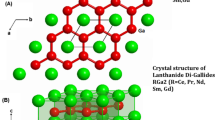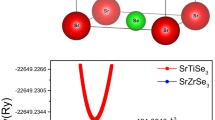Abstract
The dispersion of the linear and nonlinear optical susceptibilities is calculated for disilver germanium sulfide (Ag2GeS3) using the all-electron full potential linearized augmented plane wave (FP-LAPW) method. Calculations are performed with four exchange correlations namely local density approximation (LDA), general gradient approximation (GGA), Engel–Vosko generalized gradient approximation (EVGGA), and modified Becke–Johnson potential (mBJ). Our calculations give a band gap of 0.40 eV (LDA), 0.42 eV (GGA), 1.03 eV (EVGGA), and 1.30 eV (mBJ) in comparison with our measured gap (1.98 eV). The mBJ exchange correlation gives the best agreement with experiment. We find that the calculated linear optical susceptibilities of Ag2GeS3 show considerable anisotropy which is useful for second harmonic generation and optical parametric oscillation. To analyze the spectra of the calculated χ (2)113 (ω), χ (2)232 (ω), χ (2)311 (ω), χ (2)322 (ω), and χ (2)333 (ω), we have correlated the features of these spectra with the features of ɛ2(ω) spectra as a function of ω/2 and ω. From the calculated dominant component |χ (2)333 (ω)|, we find that the microscopic second-order hyperpolarizability, β333, the vector components along the dipole moment direction is 41.2 × 10−30 esu at static limit and 222.9 × 10−30 esu at λ = 1064 nm.





Similar content being viewed by others
Notes
Our measurements of the energy gap [the band gap of Ag2GeS3 estimated from the maximum of the intrinsic photoconductivity (λ = 575 nm) is about 2.16 eV, also estimated from the fundamental absorption edge to be 1.98 eV].
References
Deb SK, Zunger A (eds) (1987) Ternary and multinary compounds. Materials Research Society, Pittsburgh
Jaffe GE, Zunger A (1983) Phys Rev B 28:5822v
Jaffe GE, Zunger A (1984) Phys Rev B 29:1882
Rincon C, Bellabarba C (1986) Phys Rev B 33:7160
Parthe E (1964) Crystal chemistry of tetrahedral structures. Gordon and Breach, New York
Goryunova NA (1965) The chemistry of diamond-like semiconductors. Chapman and Hall, New York
Shay JL, Wernick JH (1974) Ternury chalcopyrite semiconductors: growth, electronic properties and applications. Pergamon, Oxford
Kaufmann U, Schneider J (1974) In: Treusch J (ed) Festkorperprobleme XIV. Vieweg, Braunschweig, p 229
Wagner J (1977) In: Pankove JO (ed) Electroluminescence. Springer, Berlin, p 171
Mackinnon A (1981) In: Treusch J (ed) Festkorperprobleme XXI. Vieweg, Dortmund, p 149
Miller A, Mackinnon A, Weaire D (1981) In: Ehrenreich H, Seitz F, Turubull D (eds) Solid state physics, vol 36. Academic, New York
Pamplin BR, Kiyosawa T, Mastumoto K (1979) Prog Cryst Growth Charact 1:331
Kazmerski LL (1983) Nuovo Cimento D2:2013
Shay JL, Schiavone LM, Buehier E, Wernick JH (1972) J Appl Phys 43:2805
Wagner S, Shay JL, Tell B, Kasper HM (1973) Appl Phys Lett 22:351
Levine BF (1973) Phys Rev B 7:2600 and references therein
Hopkius FK (1995) Laser Focus World 31:87
Minayev VC (1991) Glassy semiconductor alloys. Metallurgiya, Moscow (in Russian)
ICSD#41711
Dovgii YO, Kityk IV (1991) Phys Status Solidi 166B:395
Dovgii YO, Kityk IV, Man’kovskaya IG, Evstigneeva LN (1990) Phys Semicond 24(9):1004
Fedorchuk AO, Gorgut GP, Parasyuk OV, Lakshminarayana G, Kityk IV, Piasecki M (2011) J Phys Chem Solids 72:1354
Nouneh K, Kityk IV, Viennois R, Benet S, Charar S, Paschen S, Ozga K (2006) Phys Rev B 73:035329
Reshak AH, Auluck S, Piasecki M, Myronchuk GL, Parasyukd O, Kityk IV, Kamarudin H (2012) Spectrochim Acta Part A 93:274
Armand P, Ibanez A, Tonnerre JM, Bouchet-Fabre B, Philippot E (1997) Phys Rev B 56:10852
Boyd GD, Kasper H, McFee JH (1971) IEEE J Quantum Electron QE-7:563
Chemla DS, Kupcek PJ, Robertson DS, Smith RC (1971) Opt Commun 3:29
Blaha P, Schwarz K, Madsen GKH, Kvasnicka D, Luitz J (2001) WIEN2k, an augmented plane wave plus local orbitals program for calculating crystal properties. University of Technology, Vienna
Kohn W, Sham LJ (1965) Phys Rev A 140:1133
Perdew JP, Burke S, Ernzerhof M (1996) Phys Rev Lett 77:3865
Engel E, Vosko SH (1993) Phys Rev B 47:13164
Tran Fabien, Blaha Peter (2009) Phys Rev Lett 102:226401
Gao S (2003) Comput Phys Commun 153:190
Schwarz Karlheinz (2003) J Solid State Chem 176:319
Bassani F, Parravicini GP (1975) Electronic states and optical transitions in solids. Pergamon Press Ltd., Oxford, p 149
Sharma S, Dewhurst JK, Ambrosch-Draxl C (2003) Phys Rev B 67:165332
Reshak AH (2005) Ph.D. thesis, Indian Institute of Technology-Rookee, India
Reshak AH (2006) J Chem Phys 125:014708
Reshak. AH (2006) J Chem Phys 124:014707
Ambrosch-Draxl C, Sofo J (2006) Comput Phys Commun 175:1
Aspnes DE (1972) Phys Rev B 6:4648
Tributsch H, Naturforsch Z (1977) J Electroanal Chem 32A:972
Penn DR (1962) Phys Rev B 128:2093
Reshak AH, Kityk V, Auluck S (2010) J Phys Chem B 114:16705
Reshak AH, Auluck S, Kityk IV (2008) J Solid State Chem 181:789
Reshak AH, Auluck S, Kityk IV (2008) J Phys Condens Matter 20:145209
Reshak AH, Auluck S, Kityk IV (2008) Appl Phys A 91:451
Reshak AH, Auluck S (2008) PMC Phys B 1:12
Reshak AH, Auluck S, Kityk IV (2009) J Alloy Compd 473:20
Gokce B, Adles EJ, Aspnes DE, Gundogdu K (2010) Proc Natl Acad Sci 10:17503
Ouahrani T, Otero-de-la-Roza A, Reshak AH, Khenata R, Faraoun HI, Amrani B, Mebrouki M, Luanã V (2010) Phys B 405:3658
Boyd RY (1982) Principles of nonlinear optics. Academic Press, New York, p 420
Boyd RW (2008) Nonlinear optics, 3rd edn. Acadmic Press is an imprint of Elsevier. ISBN: 978-0-12-369470-6
Acknowledgements
This study was supported from the Project CENAKVA (No. CZ.1.05/2.1.00/01.0024), the Grant No. 152/2010/Z of the Grant Agency of the University of South Bohemia. School of Material Engineering, Malaysia University of Perlis, P.O. Box 77, d/a Pejabat Pos Besar, 01007 Kangar, Perlis, Malaysia. S.A. thanks Council of Scientific and Industrial Research (CSIR), National Physical Laboratory for financial support.
Author information
Authors and Affiliations
Corresponding author
Rights and permissions
About this article
Cite this article
Reshak, A.H., Kamarudin, H. & Auluck, S. Dispersion of the linear and nonlinear optical susceptibilities of disilver germanium sulfide from DFT calculations. J Mater Sci 48, 1955–1965 (2013). https://doi.org/10.1007/s10853-012-6961-6
Received:
Accepted:
Published:
Issue Date:
DOI: https://doi.org/10.1007/s10853-012-6961-6




